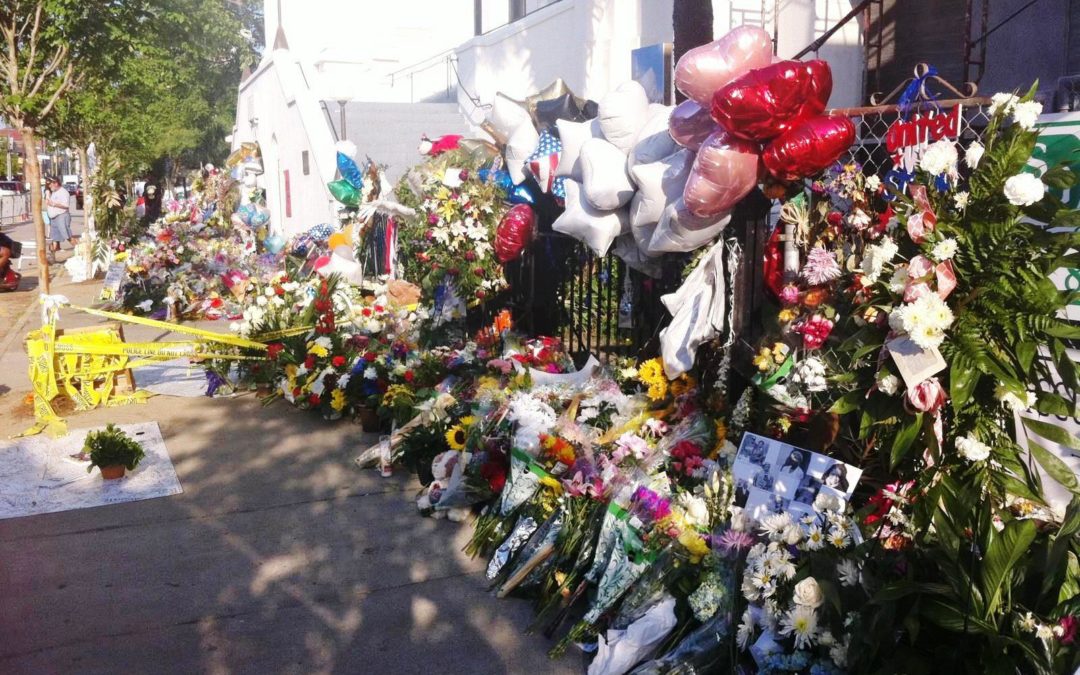How will future historians label the time we now live in?
After the Pulse Nightclub shootings in June of 2016, I reached out to Pam Schwartz, chief curator at the Orange County Regional History Center in Orlando, FL, who I knew would be spearheading the collecting of the many items left at the scene in the wake of the tragedy. On the Wednesday following, Celeste Wiley, visual materials archivist at the SC Historical Society, Meg Moughan, the records manager for the City of Charleston, and I, were on a conference call with Pam offering our help and giving advice based on our own experiences in the aftermath of the Mother Emanuel AME tragedy one year earlier—you can read more about Emanuel here and here. In May of 2017, Pam organized a session at the American Association of Museums entitled “It Could Happen to You: Collecting in the Face of Tragedy”, and invited me to participate.
When reporter David Montero from the Los Angeles Times was working on his article about “Archiving Grief: Museums Learn to Preserve Memorials Left at Mass Shootings”, he contacted Pam for her perspective, and she suggested that he contact me. We spoke for awhile and I encouraged him to contact individuals who were connected with the response to the Emanuel tragedy—parishioners, Charleston archivists, digital specialists, and others—so that he could better understand the many layers involved in “archiving grief” and, perhaps, expand on the valuable lessons learned. I don’t know if he was able to reach out to them, but he certainly understood the scope and challenges as the following excerpt illustrates.
Museums are planners by nature, moving slow and contemplating the weight of exhibits before mounting a display that puts a moment of time in historical context. They keep most of their artifacts in storage under exacting conditions to slow deterioration. When items are received by a museum, it’s usually a few at a time.
Mass shootings and the memorials that spring up are exactly the opposite. Thousands of items are subject to rain, heat and sometimes snow and build up quickly. Intake, cataloging and archiving can take years.
Jenny Hankinson, curator of collections at the Littleton Museum in Colorado, said after the Columbine High shooting more than 10,000 items were left at sites around the school. It took seven years to sort and archive such an array of items, including Beanie Babies, cassette tapes, track shoes.
– Excerpt – “Archiving Grief: Museums Learn to Preserve Memorials Left at Mass Shootings” – David Montero, LA Times
After the story appeared, I was very appreciative of what the author said and the attention that the LA Times gave to this vital subject, but like many, my overriding concern is that it could happen again. It is right that we prepare ourselves, but we see how the very act of doing so can also alter lives. It starts with the school children who must now practice active-shooter drills, the teachers who have the extraordinary responsibility of saving precious lives in a crisis, the parents who must strike a balance between reassurance and preparedness, the authorities who must think through every scenario and be prepared to do the absolute right thing because errors result in lives lost, the curators who must now focus on acquiring specialized skills so that when the time comes, they can help their communities heal while putting their own emotions on hold, and the countless others who simply try to live normal lives, but may be experiencing debilitating anxiety.
Given this reality, I think about how future historians will label the time we now live in. What evidence will they have to draw from in order to interpret this period in our society, our world? The news media and social media will, of course, be important sources portraying the horror of mass shootings and the unimaginable grief that families and friends have experienced. But what kind of hard evidence in the form of artifacts, artwork, and everyday objects would still be available if today’s historians and curators weren’t coming together to preserve them? What kind of story would be told without these tangible expressions of grief?
I have mixed feelings. I was glad to contribute my thoughts to the piece, but at the same time, I am angered by the fact that such stories still need to be written and, what’s more, that so many people across our nation are able to respond in a knowing way. It is my belief that we in the public sector need to be all the more intentional in not only preparing for the worst, but in devising programs that elucidate our common humanity, that demonstrate compassion, inclusive of the “Other”, and thereby help to prevent such tragedies from occurring again.
What do you think?
 George W. McDaniel, Ph.D., is President of McDaniel Consulting, LLC, a strategy firm that helps organizations use history to build bridges within itself and to its broader constituents. The company’s tag line, “Building Bridges through History,” is grounded in McDaniel’s personal beliefs and his experience in site management, preservation, education, board development, fundraising, and community outreach. Rather than using history to divide us, he strives to help organizations use history, especially local history, to enhance cross-cultural understanding and to support local museums, preservation, and education. Dr. McDaniel recently led volunteer efforts with Emanuel AME Church and historical organizations in Charleston to use historic preservation to enhance racial reconciliation and healing. McDaniel is also the Executive Director Emeritus of Drayton Hall, a historic site in Charleston, SC, owned by the National Trust for Historic Preservation. He retired from Drayton Hall in 2015 after 25 years of distinguished service.
George W. McDaniel, Ph.D., is President of McDaniel Consulting, LLC, a strategy firm that helps organizations use history to build bridges within itself and to its broader constituents. The company’s tag line, “Building Bridges through History,” is grounded in McDaniel’s personal beliefs and his experience in site management, preservation, education, board development, fundraising, and community outreach. Rather than using history to divide us, he strives to help organizations use history, especially local history, to enhance cross-cultural understanding and to support local museums, preservation, and education. Dr. McDaniel recently led volunteer efforts with Emanuel AME Church and historical organizations in Charleston to use historic preservation to enhance racial reconciliation and healing. McDaniel is also the Executive Director Emeritus of Drayton Hall, a historic site in Charleston, SC, owned by the National Trust for Historic Preservation. He retired from Drayton Hall in 2015 after 25 years of distinguished service.
A frequent writer, speaker, and facilitator about such issues, he can be reached at gmcdaniel4444@gmail.com or through his website at www.mcdanielconsulting.net.
Header Image: Memorabilia in front of the church following the shootings at Mother Emanuel AME, Charleston, SC.

 McDaniel Consulting LLC is a strategy firm that helps organizations use history to build bridges within itself and its broader constituents.
McDaniel Consulting LLC is a strategy firm that helps organizations use history to build bridges within itself and its broader constituents.